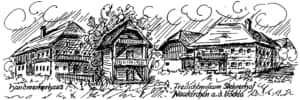Glass – Where does it come from?
We source our hand-blown glass balls and glass shapes from small glassblower manufacturers in Germany and the Czech Republic. All glass articles have a glass eyelet (and no metal hat) for hanging, into which we insert a textile tape for hanging after after the egg is completely painted and dried. Mouth-blown glass shapes can thus be recognized by the upper glass eyelet and the small glass bump at the bottom.
The Art of Glassblower Craftsmanship
In the production of mouth-blown glass balls and glass moulds, a glass flask is slowly heated by hand to about 800 °C in the gas flame. If the glass has the correct viscosity, it is blown quickly while constantly being turned.
Smooth balls and other shapes such as bells, drops, olives, onions or tree tips are produced free by the glassblower and without the use of a mold by blowing air into the glass tube.
Other glass shapes such as teapots, coffee pots, lanterns are produced in the same procedure by inserting and blowing out in the respective form. The glassblower uses its own shapes, which consist of a ceramic-like mass. Some of them are already around 100 years old and are passed down through generations.
After blowing glass or removing them from the blow mold, the objects are again briefly guided through the flame in order to reduce the tension caused by the sudden cooling.
After cooling, the remaining glass tube, called “skewer”, is cut off and the glass blower manually places the glass eye on the glass ball or glass shape for hanging.
Unique – Three-sided Balls and Four-Sided Balls
Exclusively with us you will find very special three-sided and four-sided balls in diameters of 8 cm, 10 cm and 12 cm. These are made by a small glassblowing company exclusively for us. As long as the mouth-blown glass ball has not yet cooled, the glassblower presses 3 or 4 medallions into the glass and so-called plates are created. These medallions are refined with 24 carat real gold pads and painted finely painted finely with a lot of details.
The art of glass painting
Depending on the motif, the objects are pre-primed, matted, left naturally or finished with burnt-in 24 carat gold. The painting process is done hand-free with commercially available casein paints, water-based varnishes and fine brushes made of marten hair.
It takes a steady hand and a lot of experience and skill for motifs to take shape on the predominantly curved ground.
Storage: Dry, at room temperature
Care note: We use environmentally friendly and water-soluble paints and varnishes. Our articles are therefore all non-wet wipeable and not washable!






